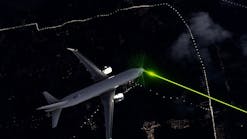5G is coming and it will be a gamechanger for connectivity. Buzz is building for this next and newest wireless standard that will succeed 4G because 5G is more than just a network upgrade, it represents a transformational shift in mobile services. Gone are the days of building a network only for mobile phones. 5G is engineered for a new generation, where billions of connected things will power smart buildings, smart cities, smart homes—and smart airports.
Understanding 5G and how it will impact airports is crucial. As the technology moves from labs to real-world deployments, here’s a brief 5G 101 guide that airport executives should take note of as commercial rollouts inch closer.
5G will deliver unbelievably fast broadband speeds, ultra-low latency and massive capacity
When using a 4G network it takes approximately six minutes to download a two-hour movie. Fast forward to 5G and this same movie can be downloaded in a mere 3.6 seconds thanks to speeds of 10 Gbps+. So when we say 5G is going to be fast—we really mean fast. The turbo-charged network will also be more responsive, thanks to one millisecond of latency, and able to handle more data. This translates to an amplified connectivity experience for passengers.
Early 5G launches will hit in 2018, but wider commercial deployments are anticipated for 2020
Tier One wireless carriers like AT&T, Sprint, T-Mobile and Verizon have reported plans to deploy 5G in select cities this year. Outside of the carrier market, companies such as Qualcomm and Intel are working on 5G chips, while hardware manufacturers are focused on 5G-compatible devices.
A flurry of 5G activities will continue over the next 20+ months, with larger commercial availability hitting in 2020 and post-2020—underscoring the need for airports to start mapping out their 5G strategies without delay. This can seem daunting, but neutral host service providers can make the transition seamless. Boingo has a long history of overseeing successful upgrade cycles, as we’ve moved our networks from 2G to 3G and 3G to 4G. 5G will be no different. Our team will continue to work with carriers to bring 5G to airports where we manage the wireless network.
Expect advances for IoT, big data and machine learning
5G will usher in boundless connectivity and intelligent automation, digitizing economies and societies. Data-heavy innovations like M2M communication, augmented reality and all things IoT will become ubiquitous.
Artificial Intelligence (AI), big data and machine learning in particular will present a big opportunity for airports, as the combination of the three will smooth the customer journey across various touchpoints. Instead of passengers being inconvenienced by an issue, data scientists can use AI, big data and machine learning to anticipate and resolve that issue before it becomes bothersome. That’s why these 5G era technologies will be incredibly important for improving the passenger experience and boosting operational efficiencies.
While 5G hasn’t officially arrived yet, there are smart data-driven solutions already making their way into airports. For example, LAX recently launched a smart restroom pilot program with next-gen traffic management systems. These provide real-time data so issues can be handled more quickly.
5G networks will require hyper-densification and shared spectrum
In recent years, airports have densified wireless networks using a mix of cellular distributed antenna systems (DAS) and Wi-Fi to combat the rapid growth of mobile data consumption. With 5G, densification strategies will be amplified, requiring “hyper-dense” network environments that bring even more nodes closer to the end user.
High-frequency millimeter waves, which will help power 5G, are driving hyper-densification, because they are capable of delivering extreme data speeds and capacity to reshape connectivity. The challenge though is millimeter waves have poor transmission—they are susceptible to blockage and typically can’t penetrate walls. To solve this, airports will require converged network solutions—including DAS, small cells and Wi-Fi—that add more base stations, antennas and access points.
With 5G, we’ll also see shared spectrum come into play, like CBRS 3.5 GHz. CBRS stands for Citizens Broadband Radio Service and is a U.S.-based initiative that dynamically allocates 3.5 GHz spectrum on demand to anyone for their exclusive use. Think of it as another piece of carrier-grade spectrum that we can deploy in airports to deliver coverage and solve the mobile data crunch.
Intelligent airport networks can revolutionize the passenger experience
There’s a lot to cover when it comes to 5G, but for airports, it’s all about reimagining the passenger experience. Ground operations, security checkpoints, runway monitoring, baggage handling and building management will be transformed. Beacons and proximity insights will strengthen operations. Timely data and analytics will inform like never before. And intelligent wireless networks that are 5G-enabled will be at the heart of it all.
It’s an exciting time to be in the aviation industry and part of the journey to 5G.
Scott Ewalt is Boingo’s Product Management, Product Development and Customer Experience lead. As Vice President, he is responsible for managing Boingo's commercial wireless product portfolio - including managed Wi-Fi, carrier solutions, managed network services, and data analytics products. This includes overseeing Boingo's “Customer 360” strategy, a data-driven approach to integrating qualitative and quantitative insights to enhance every touchpoint in the customer journey across the company’s product portfolio.
Prior to Boingo, Ewalt worked in digital marketing for Move Inc., the operator of Realtor.com, and in media planning on the Coca-Cola and McDonald’s accounts at ad agencies in Los Angeles and New York.
Ewalt holds an MBA from Pepperdine University’s George L. Graziadio School of Business and Management and a bachelor of arts from University of Southern California.


![Logo Notag Hex[1]x100 Logo Notag Hex[1]x100](https://img.aviationpros.com/files/base/cygnus/cavc/image/2020/10/logo_notag_hex_1_x100.5f9c63c6d8cae.png?auto=format,compress&fit=fill&pad=5&fill-color=white&q=45&h=139&height=139&w=250&width=250)


